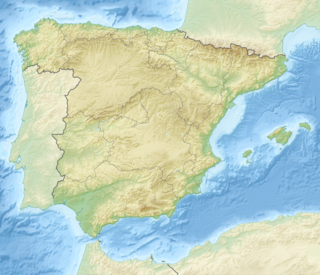
Josep Comas i Solà was a Spanish astronomer, of Catalan origin, discoverer of minor planets, comets, and double stars.

Vesto Melvin Slipher was an American astronomer who performed the first measurements of radial velocities for galaxies. He was the first to discover that distant galaxies are redshifted, thus providing the first empirical basis for the expansion of the universe. He was also the first to relate these redshifts to velocity.
Pierre Antonini is a retired French mathematics professor and amateur astronomer who has discovered several minor planets and two supernovae at his private Observatoire de Bédoin located at Bédoin, southeastern France. For many of his discoveries he used a 16-cm telescope or a 30-cm telescope.
Jaume Nomen Torres is a Spanish oral and maxillofacial surgeon, amateur astronomer and discoverer of numerous minor planets. He is of Catalan origin and became publicly known for the discovery of the near-Earth asteroid 2012 DA14 by the OAM team during the La Sagra Sky Survey. The asteroid 56561 Jaimenomen is named after him.
The Santa Lucia Stroncone Astronomical Observatory is an astronomical observatory located at 350 metres (1,150 ft) altitude in Stroncone, near the city of Terni, in Umbria, north central Italy.

Bassano Bresciano is a comune in the province of Brescia, in Lombardy. As of 2011 Bassano Bresciano had a population of 2,237.
The Črni Vrh Observatory is an astronomical observatory located in western Slovenia, close to the settlement of Črni Vrh, near the town of Idrija. The current observatory was built in 1985 and stands at an elevation of 730 metres (2,400 ft). Much of the construction was done by volunteers.

The Fabra Observatory is an astronomical observatory located in Barcelona, Catalonia, Spain pointed towards the south at 415 metres above sea level.
The Crimean Astrophysical Observatory is located at Nauchnij research campus, near the Central Crimean city of Bakhchysarai, on the Crimean peninsula. CrAO is often called simply by its location and campus name, Crimea–Nauchnij, still ranks among the worldwide most prolific discovery sites for minor planets.

Piera is a municipality that covers a large portion of the southeastern corner of the comarca of Anoia in Catalonia, Spain, on the left bank of the Anoia river. The agricultural land, mostly non-irrigated, is used for the cultivation of cereals, grapes, olives and almonds. The town itself hosts a number of light industries: textiles, plastics and construction materials. Tourism during the summer months is also relatively important for the local economy.
The Central Bureau for Astronomical Telegrams (CBAT) is the official international clearing house for information relating to transient astronomical events.

Ametlla de Mar Observatory is an astronomical observatory situated in L'Ametlla de Mar in the autonomous Catalonia region of Spain. It has received the IAU observatory code 946 and is operated by Catalan astronomer Jaume Nomen. The observatory participates in the "Unicorn Project" and in the Minor Planet Astrometry group.

Vallbona d'Anoia is a municipality in the comarca of Anoia in Catalonia, Spain. It is situated to the left of the Anoia river, on the road between Piera and Capellades. The town is served by a station on the FGC railway line R6 from Barcelona and Martorell to Igualada.

Masquefa is a municipality in the comarca of the Anoia in Catalonia, Spain. It is situated on the edge of the Penedès Depression on the road between Piera and Martorell. It is served by a station on the FGC railway line R6 from Barcelona via Martorell to Igualada.

Gekko Tenmondai is an astronomical observatory located in the Shizuoka Prefecture, Japan. It was founded in 1957 and is owned by the International Foundation for Cultural Harmony. Between 1987 and 2000, the astronomers Yoshiaki Oshima and Tetsuo Kagawa discovered 172 minor planets at this site. In 2000, this observatory was ranked 40th in the world for total asteroid discoveries.
1655 Comas Solà, provisional designation 1929 WG, is a rare-type asteroid from the central region of the asteroid belt, approximately 36 kilometers in diameter. It was discovered on 28 November 1929, by Spanish astronomer of Catalan origin, Josep Comas i Solà at the Fabra Observatory in Barcelona, Spain. It was later named after the discoverer.
Haumea was the first of the IAU-recognized dwarf planets to be discovered since Pluto in 1930. Its naming as a dwarf planet was delayed by several years due to controversy over who should receive credit for its discovery. A California Institute of Technology (Caltech) team headed by Michael E. Brown first noticed the object, but a Spanish team headed by José Luis Ortiz Moreno were the first to announce it, and so normally would receive credit. Brown accused the Spanish team of fraud, using Caltech observations without credit to make their discovery, while the Ortiz team accused the American team of political interference with the International Astronomical Union (IAU). The IAU officially recognized the Californian team's proposed name Haumea over the name proposed by the Spanish team, Ataecina, in September 2008.

Andrushivka Astronomical Observatory is a private astronomical observatory in the town suburbs of Andrushivka, Zhytomyr Oblast, Ukraine. It was established in 2001. The founder and director of the observatory is Yuri Ivashchenko. The observatory has IAU observatory code A50.
Observations of minor planets as well as comets and natural satellites of the Solar System are made by astronomical observatories all over the world and reported to the Minor Planet Center (MPC), a service of the International Astronomical Union. The MPC maintains a data base that stores all observations submitted by these registered observatories. An astrometric record consists of the position, brightness and timestamp of an observed object, besides additional information. The database contains more than 200 million records gathered over the past two centuries.
Piera refers to a municipality that covers a large portion of the southeastern corner of the comarca of Anoia in Catalonia, Spain. It may also refer to:










